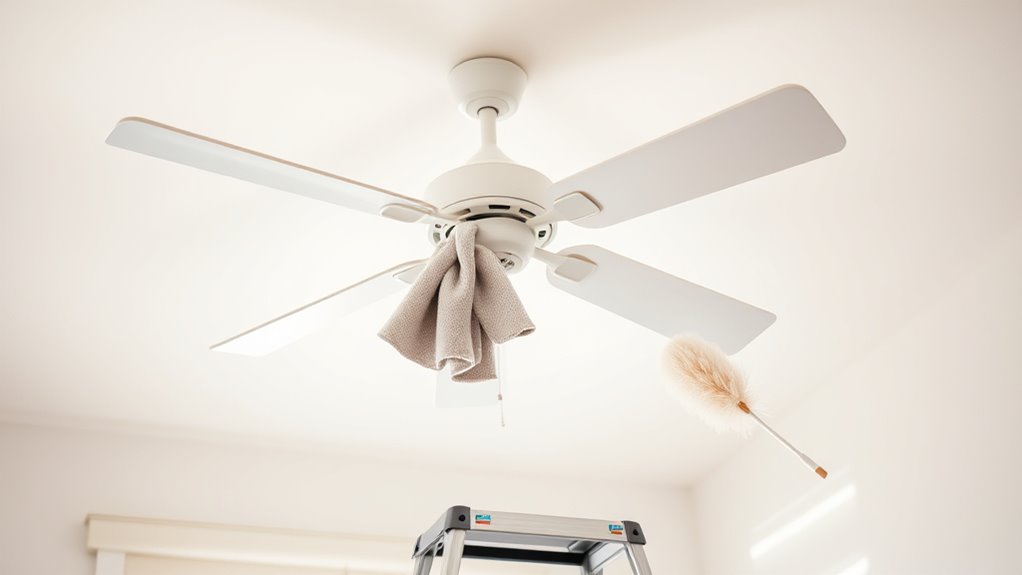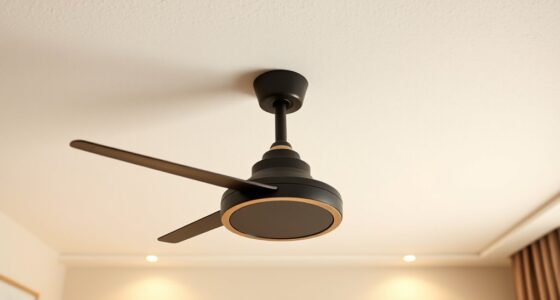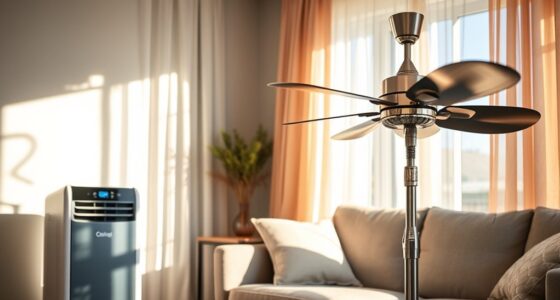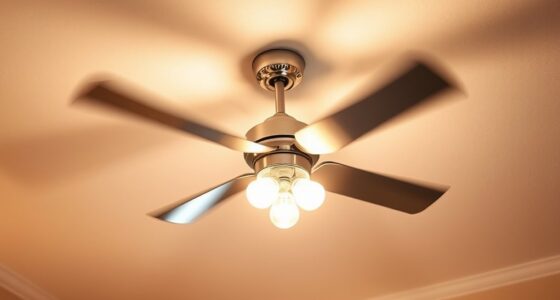To clean your ceiling fan without making a mess, first turn it off and lay down a drop cloth or old sheets to catch dust. Wear safety goggles and use a microfiber cloth or damp duster to wipe the blades from the center outward. For stubborn dirt, slip an old pillowcase over each blade and pull back to trap dust. Focus on safety and thoroughness, and you’ll keep your fan dust-free and tidy—discover more tips to make it even easier.
Key Takeaways
- Use an old pillowcase over each blade to trap dust when wiping or pulling dust off.
- Dampen a microfiber cloth lightly to clean stubborn grime without spreading dust.
- Lay a drop cloth or old sheets beneath the fan to catch falling dust and debris.
- Turn off the fan and wear safety goggles and a mask to prevent dust inhalation and protect your eyes.
- Clean in sections from the center outward, ensuring each part is dry before reassembling.
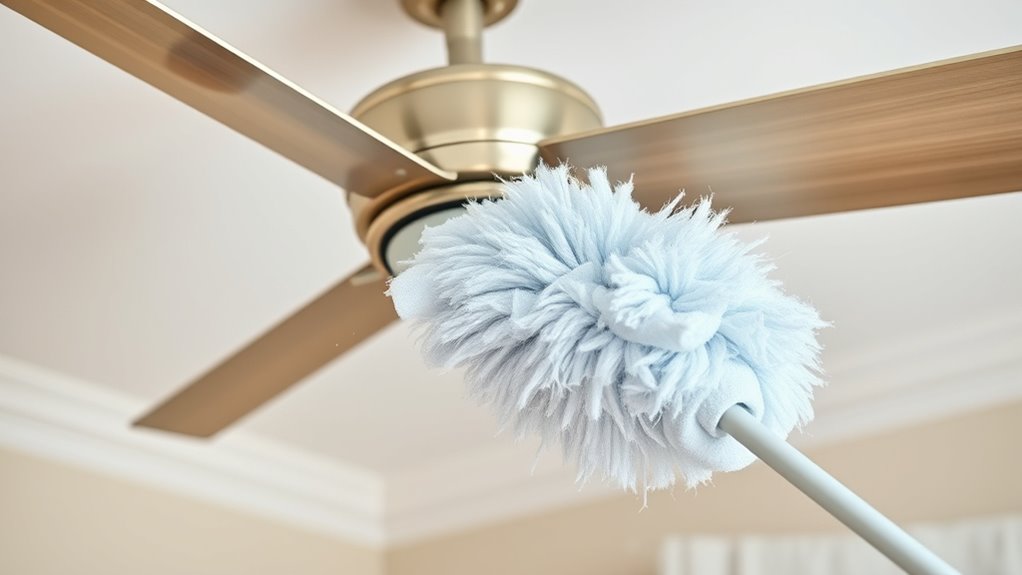
Regularly cleaning your ceiling fan is essential to keep your home fresh and make sure it runs efficiently. When you clean your fan, you not only improve air quality but also prevent dust buildup that can circulate throughout your space. Dust prevention is key, especially in homes with allergy sufferers or pets, because accumulated dust can worsen allergies and compromise your indoor air quality. Plus, a well-maintained fan operates more smoothly, saving you energy and prolonging its lifespan. But cleaning your ceiling fan without making a mess requires a bit of strategy and care to ensure your safety and keep dust from spreading everywhere.
To start, turn off the fan and use a sturdy step ladder if needed to reach it comfortably. Before you begin, lay down a drop cloth or old sheets beneath the fan to catch falling dust and debris. This simple step prevents dust from settling on your furniture or floors and makes cleanup easier. Wearing a pair of safety goggles and a mask can help protect your eyes and lungs, especially if your fan has accumulated a lot of dust. It’s important to prioritize fan safety, so avoid rushing or using unstable ladders that could cause falls or injury. When you’re ready, use a microfiber cloth or a damp duster to gently wipe down the blades, starting from the center and working outward. Microfiber cloths are excellent for dust prevention because they trap particles rather than just pushing them around. Additionally, understanding the importance of dust prevention can help you maintain a healthier indoor environment over time.
Always turn off your fan and use a sturdy ladder with a drop cloth for safe, clean ceiling fan maintenance.
For a deeper clean, you can use a pillowcase approach: slip an old pillowcase over each blade and gently pull it back, trapping dust inside. This method minimizes dust dispersal into the air, keeping your cleaning process tidy and effective. If there’s stubborn grime or sticky spots, lightly dampen your cloth with water or a mild cleaning solution, but avoid excessive moisture that could damage the fan motor or blades. After wiping, inspect the fan’s motor and light fixtures, if applicable, to remove any dust or cobwebs. Regular cleaning not only keeps your fan functioning efficiently but also prevents dust from settling into hard-to-reach areas, which can become a source of ongoing dust problems.
Throughout the process, keep your workspace well-ventilated to prevent dust from lingering in the air. When you finish, double-check that all parts are dry and secure before turning the fan back on. Consistent cleaning helps maintain fan safety by ensuring no loose or dusty components pose a hazard. It also creates a cleaner, healthier environment for everyone in your home. With just a little effort and attention to detail, you can clean your ceiling fan without making a mess, boost its performance, and enjoy fresher, cleaner air daily.
Frequently Asked Questions
Can I Clean My Ceiling Fan Without Turning It Off?
You shouldn’t clean your ceiling fan without turning it off, as it’s unsafe and can cause injury. For proper fan blade maintenance and effective fan cleaning techniques, always turn off the fan first. Use a sturdy ladder and a microfiber cloth or pillowcase to gently wipe each blade. This method minimizes mess and guarantees your fan stays clean without risking damage or personal injury during the cleaning process.
What Tools Are Best for Cleaning Ceiling Fan Blades?
For effective dust removal from ceiling fan blades, you’ll want to use a microfiber cloth or a damp sponge to trap dust without spreading it around. A step ladder makes reaching easier. Consider using a gentle cleaning solution like a mix of water and a few drops of dish soap for stubborn grime. Avoid harsh chemicals that could damage the blades. These tools help clean efficiently while keeping your space mess-free.
How Often Should I Clean My Ceiling Fan?
You should clean your ceiling fan at least once every two to three months. Regular cleaning helps control dust accumulation, preventing buildup that can circulate allergens and dirt. If you notice more dust or allergens, increase the cleaning frequency. Keeping a consistent schedule guarantees your fan stays clean and functions efficiently, while minimizing messes. Regular maintenance also extends the lifespan of your fan and improves indoor air quality.
Is It Safe to Use Water on Ceiling Fan Motor?
Using water on your ceiling fan motor isn’t safe because of electrical safety concerns. Water can cause damage to the motor’s wiring, risking short circuits or electrical shock. To avoid water damage, keep the motor dry and use a damp cloth for cleaning the blades and exterior parts. Always unplug the fan before cleaning to guarantee safety and prevent accidental electrical issues.
Can I Clean Ceiling Fans With LED or Smart Bulbs?
You can safely clean ceiling fans with LED bulbs or smart bulbs, but you should turn off the power first. Carefully remove the bulbs if possible, or gently wipe around them. Use a soft, damp cloth for the fan blades and a dry cloth for the bulbs. Avoid getting water directly on LED or smart bulbs to prevent damage. Always handle the bulbs gently to avoid breaking or dislodging them.
Conclusion
Now that you’ve conquered your ceiling fan mess, give yourself a well-deserved high-five—preferably not with your dust-covered hand. Remember, a clean fan not only keeps the air fresh but also boosts your interior decor reputation. So, next time it looks like a bird’s playground, don’t panic; just follow these simple steps and become the hero your ceiling fan never knew it needed. Happy cleaning, and may your fan spin as smoothly as your newfound confidence!
